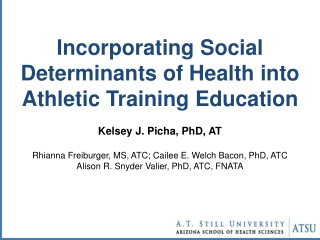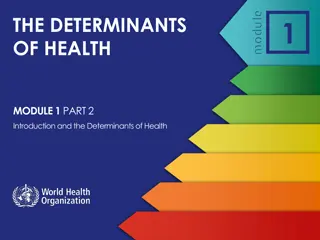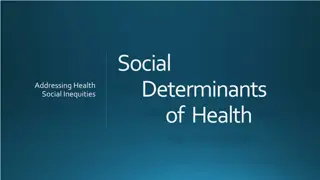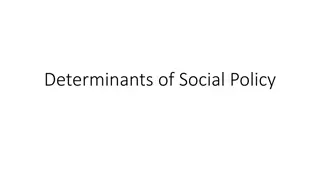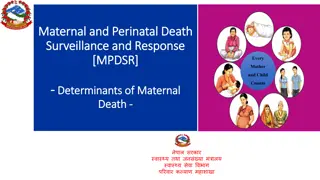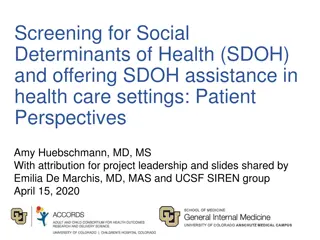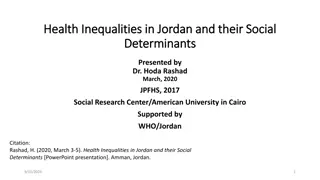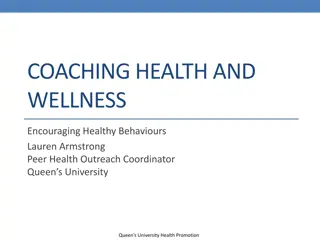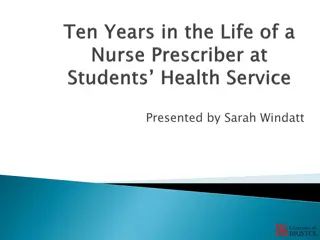Understanding Social Determinants of Health (SDH) and the Nurse's Role
Explore the impact of Social Determinants of Health (SDH) on individual and population health outcomes. Learn about key SDH factors, the nurse's role in addressing SDH needs, and how SDH influence overall well-being. Enhance your understanding of SDH through examples and discussions on factors like housing conditions, access to education, income, and more.
Download Presentation

Please find below an Image/Link to download the presentation.
The content on the website is provided AS IS for your information and personal use only. It may not be sold, licensed, or shared on other websites without obtaining consent from the author. Download presentation by click this link. If you encounter any issues during the download, it is possible that the publisher has removed the file from their server.
E N D
Presentation Transcript
Attachment C THE ESSENTIAL ROLE OF THE NURSE IN IMPROVING HEALTH OUTCOMES: A CORE DETERMINANTS OF HEALTH EDUCATION MODULE AND NURSING ASSESSMENT TOOL, THE CORE 5
OBJECTIVES Upon completion of this course, you will be able to: Discuss Social Determinants of Health (SDH) Define key words and concepts related to the SDH Recognize the five core determinants of health (CDH) factors selected by The Centers for Medicare & Medicaid Services (CMS) Identify examples of the five core CDH factors Explain the role of the nurse when caring for patients who have unmet CDH needs
SOCIAL DETERMINANTS OF HEALTH (SDH) Social Determinants of Health (SDH) influence and predict health outcomes of individuals and populations. Social factors are greater predictors of health and well-being than clinical status. 80% of overall health is driven by SDH 20% of overall health is driven by clinical status
WHAT ARE SDH? SDH are conditions and resources in the environments in which people are: Born Live Learn Work Worship Play These six factors affect: Overall Health and Well-Being Quality-of-Life Outcomes Health Risks 1. 2. 3. These three circumstances, which are influenced by policy, are shaped by the distribution of money, power, and resources at national, state, and local levels The distribution of SDH across populations determines length and quality of life.
KEY TERMS: SOCIAL DETERMINANTS OF HEALTH (SDH) Safe and affordable housing Access to education Public safety Availability of healthy foods Income Local emergency services Local health services Social relationships Transportation Resources School Place of worship Workplace Neighborhood Green space Housing conditions Roads Climate Clean water and air Exposure to pollution Environments Economic policies and systems Development agendas Social norms Social policies Political systems Public Policy
QUESTION ONE:SOCIAL DETERMINANTS OF HEALTH (SDH) Which of the following are examples of SDH? (click arrow next to the correct answer) A. Exposure to Violence Wealth Discrimination Housing Condition All of the Above
QUESTION ONE:SOCIAL DETERMINANTS OF HEALTH (SDH) CORRECT! Exposure to violence, wealth, discrimination, housing conditions are all examples of SDH.
QUESTION TWO:SOCIAL DETERMINANTS OF HEALTH (SDH) 80% of overall health is driven by SDH? (click arrow next to the correct answer) A. True False
QUESTION TWO:SOCIAL DETERMINANTS OF HEALTH (SDH) CORRECT! 80% of overall health is driven by SDH. Only 20% of overall health is driven by clinical status.
VIDEO: SOCIAL DETERMINANTS OF HEALTH (SDH) This video depicting Betty and Leslie provides a description of how the impact of SDH on quality-of-life outcomes and health risks may vary and contribute to health inequities. https://www.youtube.com/watch?v=B3RymMHz-sI&app=desktop
KEY TERMS: SOCIAL DETERMINANTS OF HEALTH (SDH) Health equity Image result for health inequality clipart When everyone in a community has the ability to achieve the highest level of health possible, regardless of who they are, how much money they have or where they live. Health disparities Measureable differences in the incidence and prevalence of health conditions, health status and outcomes between groups Health inequities Health disparities that are the result of the systematic and unjust distribution of life enhancing resources (social determinants).
HEALTH EQUITY Health equity is NOT giving everyone the same resources. Health equity is distributing resources based on individual and community need Gives all individuals the opportunity to achieve the highest level of health outcomes.
OUR ENVIRONMENTS CULTIVATE OUR COMMUNITIES & OUR COMMUNITIES NURTURE OUR HEALTH .
QUESTION THREE:SOCIAL DETERMINANTS OF HEALTH (SDH) Health outcomes are solely determined by the individual choices made throughout life. (click arrow next to the correct answer) True False
QUESTION THREE:SOCIAL DETERMINANTS OF HEALTH (SDH) CORRECT! While individual behaviors is a health factor, health outcomes are mostly influenced by socio-economic factors and physical environment. Clinical status 20% Individual health behaviors 30% Physical environment 10% Socio-economic factors 40%
QUESTION FOUR:SOCIAL DETERMINANTS OF HEALTH (SDH) Which SDH did Leslie experience that contributed to her poor health outcomes? (click arrow next to the correct answer) A. Education B. Family Support C. Job Opportunities D. Income E. All of the Above
QUESTION FOUR:SOCIAL DETERMINANTS OF HEALTH (SDH) CORRECT! Education, family support, job opportunities and income are all SDH that influence health outcomes.
QUESTION FIVE:SOCIAL DETERMINANTS OF HEALTH (SDH) Leslie developed Type 2 DM due to lack of access to healthy foods and safe physical activity options within her community. Safe activity and healthy food options are examples of what key concept? (click arrow next to the correct answer) A. Health Equities B. Health Disparities C. Health Inequities D. All of the Above
QUESTION FIVE:SOCIAL DETERMINANTS OF HEALTH (SDH) CORRECT! Lack of access to healthy foods and safe physical activity are systematic health inequities that contributed to Leslie s health status including Type 2 DM.
HEALTH-RELATED CORE NEEDS IN CLINICAL SETTINGS The impact Core Determinants of Health (CDH) have on health and healthcare utilization is well-established. EXAMPLES Food insecurity Access to utilities Housing instability Access to transportation Interpersonal violence
HEALTH-RELATED CORE NEEDS IN CLINICAL SETTINGS Food insecurity Access to transportation Interpersonal violence Housing instability Access to utilities These are the five core determinants of health (CDH) factors selected by The Centers for Medicare & Medicaid Services (CMS) based on: 1. High-quality evidence exists linking these CDH to poor health and/or increased health care utilization and cost 2. The need can be met by community service providers 3. The need is not systemically addressed by health care providers
HOUSING INSTABILITY Unmet housing needs consists of: Homelessness Includes living on a bus, in a train station, or in an abandoned building Transient living situation i.e. couch surfing with friends/family, frequent moving Losing or threat of losing housing Includes the inability to pay mortgage or rent Poor housing quality Housing instability has been shown to be associated with: Poor health outcomes Decreased access to care Increased use of acute-care services
FOOD INSECURITY Food security is defined as: Access by all people at all times to enough food for an active, healthy life. Malnutrition has been documented to have adverse affects on health. Food insecurity is associated with difficulties receiving healthcare and negatively impacting health outcomes.
ACCESS TO TRANSPORTATION Unmet transportation needs encompass the lack of transportation to get to any destinations needed for daily living and healthcare Transportation barriers lead to: These consequences lead to poor management of chronic illness and worse health outcomes. Inability to access healthy foods Decreased employment or educational opportunities Rescheduled or missed medical appointments
ACCESS TO UTILITIES Lack of these services compromise activities of daily living and components of health in the home. Inability to have or maintain these basic housing services makes living conditions unsafe and prevent healthy living. Electric Utilities Water Gas Heat
INTERPERSONAL VIOLENCE Interpersonal violence includes: intimate partner violence elder abuse child abuse unsafe neighborhood If people feel comfortable and safe in their environment, they are more likely to thrive physically and emotionally.
QUESTION SIX:CORE DETERMINANTS OF HEALTH (CDH) According to The CMS, which CDH can help can help reverse damaging health effects: (click arrow next to the correct answer) A. Transportation B. Healthy Food Options C. Safe Environment D. Housing Stability E. All of the Above
QUESTION SIX:CORE DETERMINANTS OF HEALTH (CDH) CORRECT! CDH such as housing instability, food insecurity, access to public utilities, transportation, and exposure to interpersonal violence, drive health care utilization and impact health outcomes
WHAT IS THE NURSES ROLE? As the largest group of health care professionals, nurses witness the impact of CDH on a daily basis. 1. It is vital that nurses appropriately assess CDH that strengthen or impede health outcomes in order to improve health. 2. When nurses identify and address CDH and core needs significant improvements in health could be made.
WHAT IS THE NURSES ROLE? 3. Nurses should connect patients and families with appropriate services and/or resources, while building on identified strengths and assets. There may be established relationships with some community resources; therefore, it is important to ask about known resources in their communities. 4. Nurses must know that the referral process requires: Health-related core needs resources Partnerships with community-based services Reliable follow-up system
CORE 5 SCREENING TOOL The Core Determinants Abbreviated Screening Tool (Core 5) is recommended for use as part of routine nurse assessment and/or the intake/admission process. YES NO 1. Do you/your family worry about whether your food will run out and you won t be able to get more?1, 2 2. Are you worried about losing your housing, or are you homeless?3 3. Are you currently having issues at home with your utilities such as your heat, electric, natural gas or water?4, 5 4. Has a lack of transportation kept you from attending medical appointments or from work, or from getting things you need for daily living?6, 7, 8 5. Are you worried that someone may hurt you or your family?9
RESOURCES Every community has unique resources at: Most clinical settings have people who can help facilitate needed referrals and follow-up: non-profit organizations public programs social workers advocacy groups Family/patient advocates Case managers Identifying local resources may be accomplished by: Care coordination and/or community health workers contacting local governmental Ongoing follow-up can help to prioritize family needs public health departments professional organizations and agencies Attempts at addressing all needs at once may be overwhelming for the clinician and the family county and/or state medical or public societies exploring local services via the internet.
QUESTION SEVEN:CORE DETERMINANTS OF HEALTH (CDH) Leslie presents to her health care provider for uncontrolled diabetes. Upon completion of the CDH assessment the nurse learns that Leslie doesn t have a grocery store in her neighborhood and shops for food at a local gas station. What organization should the nurse refer Leslie to? (click arrow next to the correct answer) A. Local Food Bank B. Local Department Job and Family Services C. Local Health Department D. All of the Above
QUESTION SEVEN:CORE DETERMINANTS OF HEALTH (CDH) CORRECT! The local health department, job & family services and/or food bank would be an appropriate referral for Leslie to obtain help to secure healthy food
FOR QUESTIONS OR MORE INFORMATION: Alexandria Jones, MS, RN Nancie Bechtel, MPH, BSN, RN, EMT Director of Nursing/Chief, Bureau of Health Promotion Ohio Department of Health Alexandria.Jones@odh.ohio.gov Assistant Health Commissioner/Chief Nursing Officer Columbus Public Health NMBechtel@columbus.gov DeAnna Hawkins, MSN, RN, NEA-BC Clinical Director Cincinnati Children's Hospital Medical Center deanna.hawkins@cchmc.org
REFERENCES Billioux, A., Verlander, K., Anthony, s., & Alley, D. (2017). Standardized screening for health-related social needs in clinical settings: the accountable health communities screening tool. Retrieved from https://nam.edu/wp-content/uploads/2017/05/Standardized-Screening-for-Health-Related-Social-Needs-in-Clinical-Settings.pdf Center for Disease Control and Prevention. (2013). CDC promoting health equity: A resource to help communities address social determinants of health. Retrieved from https://www.cdc.gov/nccdphp/dch/programs/healthycommunitiesprogram/overview/healthequity.htm Chung, E. K., et al. (2016). Screening for social determinants of health among children and families living in poverty: A guide for clinician. Current Problems in Pediatric and Adolescent Health Care 46(5): 135-153. HealthyPeople.gov. (2017). Social determinants of health. Retrieved from https://www.healthypeople.gov/2020/topics-objectives/topic/social-determinants-of-health#five Health Policy Institute of Ohio, (2017). Roadmaps to equity. Retrieved from http://www.healthpolicyohio.org/roadmaps-to-equity-opportunities-for-closing-health-gaps/ James, C. (2016). Q&A: Building the business case for achieving health equity. Centers for Medicare & Medicaid Services. Retrieved from http://www.modernhealthcare.com/article/20160423/MAGAZINE/304239954 Kushel, M., Gupta, R., Gee, L., & Haas, J., S. (2006). Housing instability and food insecurity as barriers to health among low-income Americans. Journal of General Internal Medicine, 21(1), 71-77. Magingley, S., Mack, K., & Kaur, T. (2014). University of British Columbia SPPH Social determinants of health. Retrieved from https://www.youtube.com/watch?v=B3RymMHz- sI&app=desktop Robert Wood Johnson Foundation. (2016). County healthy rankings & roadmaps: Building a culture of health, county by county. Retrieved from http://www.countyhealthrankings.org/our-approach
REFERENCES Robert Wood Johnson Foundation. (2017). Built environment and physical conditions. Retrieved from http://www.cultureofhealth.org/en/taking-action/creating-healthier- communities/built-environment.html Schickedanz, A., & T. R. Coker Surveillance and screening for social determinants of health Where do we start and where are we headed? Current Problems in Pediatric and Adolescent Health Care 46(5): 154-156. Sox, H. C. (2013). Resolving the tension between population health and individual health care. The Journal of the American Medical Association, 310(18), 1933-1934. Syed, T., S., Gerber, B., S., & Sharp, L., K. (2013). Traveling towards disease: Transportation barriers to health care access. Journal of Community Health, 38(5), 976-993. The Education Trust. (2014). Retrieved from https://edtrust.org/the-equity-line/equity-and-equality-are-not-equal/ The Henry J. Kaiser Family Foundation. (2016). Total number of professionally active nurses. Retrieved from http://kff.org/other/state-indicator/total-registered- nurses/?currentTimeframe=0 World Health Organization. (2017). Social determinants of health. Retrieved from http://www.who.int/social_determinants/en/


